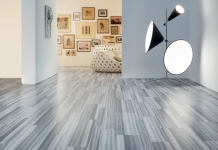Sound dampening felt panels can help treat any room they occupy. However, there are some drawbacks to using this method to improve your room’s sound environment.
If you go this route to improve your room’s sound environment, you should look for companies that offer easy installation processes and high noise reduction coefficients. This article discusses the pros and cons of sound-dampening panels and tells you the best way to maximize your sound treatment plan.
What is Soundproof or Acoustic Foam?
Acoustic soundproof or sound dampening foam panels are used to improve the sound environment of a given room. You can hang them on the wall or the ceiling, and they reduce the residual sound within a room, making it easier for people to communicate.
Recording studios typically install soundproofing foam because it reduces the resonance within the studio. However, most environments don’t need that level of soundproofing, and they use sound-dampening foam panels to absorb sound and reduce the reverberation within a room.
If sound-dampening material does its job, the noise won’t be as distracting, and speech will be more audible.
What Is Soundproof Foam Insulation?
Soundproof wall panels stop sound waves from entering the given space you’re occupying. You need this level of sound treatment if you need to maintain a pure sound environment. If you only need to reduce the sound within your space, sound dampening panels make more sense.
How to Improve the Sound Inside a Room Using Acoustic Foam?
Sound treatment improves the sound within a room by either deflecting sound back into the environment where it originates (soundproofing) or absorbing the sound using porous materials such as felt (sound dampening). With soundproofing materials, you can even use a bass trap kit to stop the low-end waves from resonating.
How to Soundproof a Room?
Soundproofing a room is much more invasive than putting the sound treatment in a room. Professional soundproofing requires installing panels in between walls, which can cost thousands of dollars.
Pro- Reduces Echo and Reverberation
The obvious problem that sound dampening panels respond to is that they reduce reverberation and echoes within any room. Whether you place them in your living room or your office, they will improve your sound quality. Furniture, rugs, and curtains can do some to reduce echoes and reverberations, but they won’t go all the way. Sound dampening panels will always do the trick.
Pro- Increased Productivity
There are always distractions at home. These distractions kill productivity and prevent you from accomplishing your goals. Why stress over your room’s sound environment when you can implement sound dampening panels to mitigate your sound pollution?
Adding sound dampening panels will turn your at-home office into the efficient sanctuary it should be.
Pro – Minimal Damage To Walls
Felt acoustic panels are effortless to install and cause minimal damage to interior walls. It’s a bonus that these panels are easy to remove, and most have peel-off tabs that make repurposing and re-design possible.
Pro – Transportable & Long Lasting
No matter where your next endeavor takes you, sound dampening panels can follow you to make your environment more sound friendly. These panels work exceptionally well for at-home offices where you don’t need the extensive sound treatment soundproofing panels to provide.
Pro- Cost
Felt acoustic panels are preferable to soundproofing panels from a cost perspective. Soundproofing treatments can cost thousands of dollars, and if you only need minimal sound treatment, they simply aren’t worth the financial commitment. Sound dampening panels offer ulterior methods to getting the right amount of sound treatment for your room.
Con- Efficacy
Sound dampening panels won’t give you the pure sound environment you get from soundproofing materials. However, unless you own a recording studio or need a pristine sound environment for other reasons, this shouldn’t be a problem.
Con- Quality Depends on the Company
Another drawback to acoustic felt panels is that their quality varies according to the manufacturer. A company can complain their product improves a room’s sound environment, but buyers beware- these companies can fabricate the efficacy of their felt acoustic panels.
When buying your acoustic panels, make sure to check the company’s noise reduction coefficient. The noise reduction coefficient tells the consumer how much the acoustic felt panels reduce sound within a given environment.
Con- Installation Process Can Be Labor Intensive
Installing sound dampening panels can be labor intensive if you don’t choose the right company. The best sound dampening panels make easy-to-install sound dampening panels. If you find yourself having to spend an entire afternoon installing your sound dampening panels, something has gone wrong. Try to use a company that cares about making their installation process as simple as can be.
Conclusion- The Pros and Cons of Sound Dampening Panels
When it comes to soundproofing and sound dampening panels, you need to weigh the pros and cons before choosing which solution suits your needs best. If you are only looking to minimize the sound pollution within your space, then sound dampening panels are likely the best option for you.
However, if you have a recording studio or need a pure sound environment, soundproofing panels are most likely your best option. When choosing your sound dampening panels, you should consider whether the company you’re considering can provide you with the sound treatment you need.








































